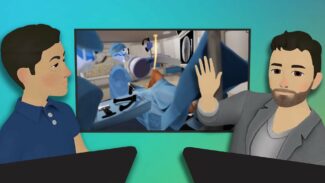Surgical education platform Osso VR recently announced $66 million in funding raised in its Series C funding round.
The startup’s founder and CEO, Dr. Justin Barad, sat down with us in VR to discuss the company’s path and potential to impact the healthcare industry.
“Technically, Osso VR is based in San Francisco, but since day one that first day in October 2016, we’ve always been fully remote and VR enabled and people thought we were crazy back then, but obviously this is more of a thing now,” Dr. Barad told us. “So we’ve always been and always will be a fully remote company. And as of today, we’re about 160 full-time employees and we’ll be 300 by the end of the year.”
The latest funding round was led by Oak HC/FT but also included participation from Signalfire, GSR Ventures, Tiger Global Management and Kaiser Permanente Ventures. Osso says that the funding will be used to accelerate its “initiative to broaden access to surgical education for all healthcare professionals and continue the investment in hiring top-tier talent to bring high-fidelity surgical training experiences to additional specialty areas.”
“In two years, maybe we’ll be somewhere between 600 to 800 people. Some of our focus specialties include orthopedics and interventional specialties, so interventional cardiology, interventional radiology, vascular surgery. So I’d like us to see 90% to 100% penetration with healthcare professionals in these specialties,” Dr. Barad said.
“Our mission is to improve outcomes, increase the adoption of higher value technologies and techniques and democratize access to surgical education for everyone everywhere. And so my vision for Osso VR, however long that may take, five to 10 years, is that every single procedure that you could possibly do is simulated in this universal simulation platform called Osso. And that it is also a central repository for all proficiency data in healthcare.”
The platform allows medical professionals to engage in interactive training with virtual reality headsets, custom hardware and haptic devices. Since launch, the platform has seen many updates and expansions, upping the visual fidelity of the experience and expanding the training selection to include new areas.
“If you’re going in for…something like a joint replacement, or some commonly performed sports procedure, I would say the likelihood would be quite high in a couple of years, I would say 60% to 80%, that that healthcare professional has at least done some VR training for the relevant procedure,” Dr. Barad said. “And then if you go a few years out, what’s interesting is this incoming generation they’re not just excited about this technology, they expect it.”
The $66 million Series C funding follows from the last funding round mid-last year, which raised $27 million.
You can check out our full interview with Dr. Barad in the video embedded above or over on our YouTube channel, discussing his path to the latest funding round and his plans for Osso in the future.





